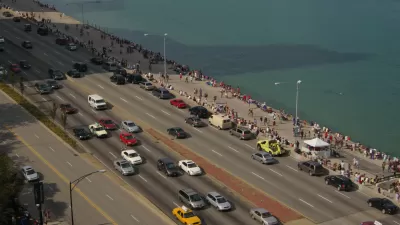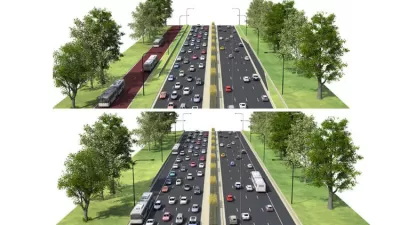A local architect produced a DIY design to push the Illinois Department of Transportation to think big with the "Redefine the Drive" project on North Lake Shore Drive. With the proposal: invitations for more local designers to participate.
Steven Vance reports: "Local architect John Krause sees the reconstruction of North Lake Shore Drive, one of Chicago’s most scenic locations, as a chance to think big — not just about the road, but also about parks, transit, trails, the shoreline, and the future of the city alongside it. The Illinois Department of Transportation isn’t used to thinking like that, though, and so Krause sees its 'Redefine the Drive' project as a process 'that looks and feels suboptimal.'"
According to Vance, "IDOT is currently in the study phase of a decade-long project that will recreate both the boulevard and access to Lincoln Park. It will be years until IDOT has a refined design, so as a first step IDOT must identify what, exactly, they want to do — what they call a Purpose and Needs Statement for the project. Krause is on one of the project task forces, and helped bring to light that IDOT’s original objectives focused on personal vehicle congestion and traffic issues, and was blind to the road’s effects upon parks, the Lakefront Trail, and citywide mobility."
Krause's design calls for a light rail transit route, beachfront entertainment and retail uses, a "Conservation Campus," and more. An earlier, citizen-commissioned design proposal (designed by VOA Associates) with similar political motivations suggested expansive new open spaces.
For his part, Krause seems just as interested in bringing more designs and designers to the table as he is in own design: "'It’s a shame,' he says, 'that there isn’t more public engagement of talented designers in this important process.' He adds that a competition, similar to one hosted by the Chicago Architecture Foundation to solicit designs for Central Loop BRT stations, 'might be a way to get Chicago’s professional designers involved.'"
For more on the IDOT process and revisions to the Purpose and Needs Statement, see an article by Charles Papanek from June.
FULL STORY: Architect Urges Big-Picture, Design Thinking For North Lake Shore Drive

Maui's Vacation Rental Debate Turns Ugly
Verbal attacks, misinformation campaigns and fistfights plague a high-stakes debate to convert thousands of vacation rentals into long-term housing.

Planetizen Federal Action Tracker
A weekly monitor of how Trump’s orders and actions are impacting planners and planning in America.

In Urban Planning, AI Prompting Could be the New Design Thinking
Creativity has long been key to great urban design. What if we see AI as our new creative partner?

King County Supportive Housing Program Offers Hope for Unhoused Residents
The county is taking a ‘Housing First’ approach that prioritizes getting people into housing, then offering wraparound supportive services.

Researchers Use AI to Get Clearer Picture of US Housing
Analysts are using artificial intelligence to supercharge their research by allowing them to comb through data faster. Though these AI tools can be error prone, they save time and housing researchers are optimistic about the future.

Making Shared Micromobility More Inclusive
Cities and shared mobility system operators can do more to include people with disabilities in planning and operations, per a new report.
Urban Design for Planners 1: Software Tools
This six-course series explores essential urban design concepts using open source software and equips planners with the tools they need to participate fully in the urban design process.
Planning for Universal Design
Learn the tools for implementing Universal Design in planning regulations.
planning NEXT
Appalachian Highlands Housing Partners
Mpact (founded as Rail~Volution)
City of Camden Redevelopment Agency
City of Astoria
City of Portland
City of Laramie




























